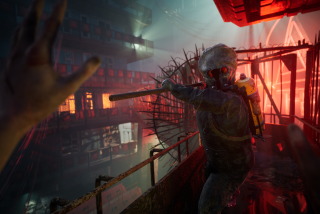Sweet Alice Doesn’t Live Here Anymore
- Share via
Lewis Carroll’s Wonderland, not the sugary, sanitized Walt Disney version, was one of the strangest, creepiest places imaginable. “American McGee’s Alice,” a third-person PC action adventure, takes strangeness and creepiness to a whole new level with a Wonderland that oozes darkness and seems to sigh under its own weight.
Set several years after Alice’s original adventures in Wonderland, “Alice” finds the blue-frocked heroine strapped to a grimy bed in an insane asylum and looking like some emaciated junkie. From there, she flitters back to Wonderland to find the place turned into a Dantean vision of suffering and pain. Even once-friendly fools block her way as she attempts to set things right.
As a former level designer for Id Software, the company behind hits such as “Doom” and “Quake,” McGee clearly understands the role of visuals in a game. His eye for detail and ability to set a mood create environments that seem almost alive, pulsing with gloom and sadness. It’s this ability to swallow players in a fantasy that makes “Alice” seem like more than it really is.
Despite its beautiful imagery and dark wit, “Alice” remains at its core a fairly standard action game that depends more on jumping and fighting than on thinking and imagining. Its puzzles are often clever, but not so much that they really stand out. In fact, most players can do just fine in “Alice” with a steady aim and fast fingers.
Players control Alice as she wanders through Wonderland with the standard mouse-keyboard combination common to first- and third-person games. Control generally is tight, although Alice’s jumping is not very refined. The game compensates for that with a little footprint target that shows where Alice will land on a jump. It helps, but in fast action, it’s easy to overlook.
As an action game, “Alice” delivers. The demented enemies range from mindless chess pieces to stinging fire imps. All move smartly through the luscious levels, and on more difficult settings, they are unrelenting in their resolve to destroy Alice.
Players face these kooks with an arsenal of toys that ranges from a standard knife to an exploding Jack-in-the-box. And in a creative twist on the standard health meter, “Alice” employs two gauges, one for sanity and one for will. When Alice loses her sanity and goes completely bonkers, the game ends. Strength of will determines the power of her toys.
But at times, “Alice” gets bogged down in chatter more appropriate to role-playing games. Alice talks to almost everyone she meets, and the exchanges often veer off into stilted dialogue that sounds witty at first but quickly gets old and annoying.
Ultimately, “Alice” seems to have trouble deciding what it is. Is it an action game in a novel setting? Or is it an adventure? It borrows elements from both and blends them in a world where each turn reveals a more stunning scene. But the blend is not seamless, and “Alice” suffers for it.
‘World Destruction League: Thunder Tanks’
When a video game begins levels with “We’ve got chili con carnage in three, two, one,” it’s generally safe to assume that what follows is far from intellectual fare. Such is the case with “World Destruction League: Thunder Tanks,” a tank-based combat game for the original Sony PlayStation as well as PS2.
Set in a future where entertainment comes at the expense of someone else’s life, “Thunder Tanks” follows the exploits of the World Destruction League. Imagine the XFL with mechanized armor called Berserker, Scorcher and Marauder. Combatants blast each other to bits to the cheers of the crowd and witty banter of on-air commentators.
The multi-player action of “Thunder Tanks” is not bad. Although the game boasts the ability to host as many as four players at once, such a skirmish requires Sony’s Multi-Tap adapter because PlayStation and PS2 come with only two built-in controller ports.
There’s very little new about “Thunder Tanks.” Anyone who plays video games regularly has probably duked it out in countless games just like “Thunder Tanks.” Sure, the tanks are easy to control and the arenas are packed with power-ups, but everything about the game has a “been there, done that” kind of feel.
‘Hoyle Card Games’
I’ve recently gone nuts for a series of Hoyle games for Game Boy Color. First it was “Hoyle Casino,” which offers everything from poker and blackjack to craps and roulette. Now it’s “Hoyle Card Games,” a tidy collection of 14 favorites--from Old Maid and Go Fish to Cribbage and Solitaire.
These games succeed because they are simple and straightforward. Even someone who’s never played a video game before can master “Card Games” within a few minutes. Although “Casino” aims squarely at adults, “Card Games” appeals to all ages and gives parents a simple way to play video games with their kids.
Inherently a two-player game, “Card Games” allows users to link two Game Boys together for head-to-head play. It’s great for cramped flights or long car trips when traditional playing cards can be tough to keep together.
As a single-player title, “Card Games” is not so fun. Players square off against computer-controlled opponents who play too slowly, something not helped by animations that get tired fast.
*
Aaron Curtiss is editor of Tech Times.
(BEGIN TEXT OF INFOBOX / INFOGRAPHIC)
The Skinny
Title: “American McGee’s Alice”
Genre: Third-person action-adventure
Price: $50
Platform: PC
System requirements: Pentium II 400 with 64 MB of RAM, 600 MB of available hard disk space and a graphics card with at least 16 MB of video RAM
Publisher: Electronic Arts
ESRB* rating: Mature
The good: Haunting beauty
The bad: Pretty standard play
Bottom line: Definitely worth a spin
*
*
Title: “World Destruction League: Thunder Tanks”
Genre: Tank-based combat
Price: $20 to $50, depending on platform
Platform: Sony PlayStation and PlayStation 2
Publisher: 3DO
ESRB rating: Teen
The good: Engaging multi-player combat
The bad: Been there, done that
Bottom line: Rent it
*
*
Title: “Hoyle Card Games”
Genre: Card-game compilation
Price: $30
Platform: Game Boy Color
Publisher: Sierra
ESRB rating: Everyone
The good: Many different games
The bad: Boring animations
Bottom line: A handy travel pal
*Entertainment Software Ratings Board
More to Read
The biggest entertainment stories
Get our big stories about Hollywood, film, television, music, arts, culture and more right in your inbox as soon as they publish.
You may occasionally receive promotional content from the Los Angeles Times.










